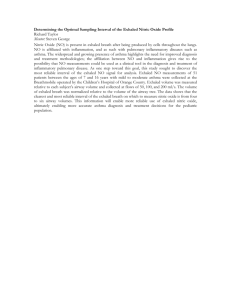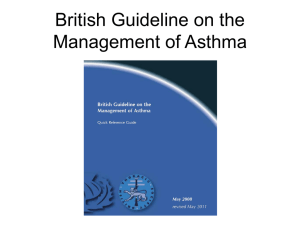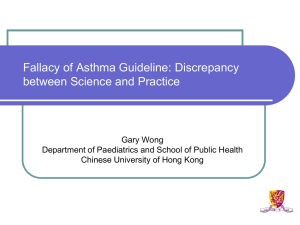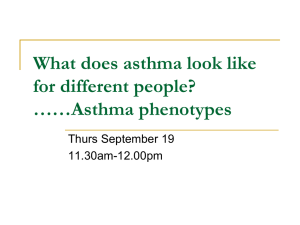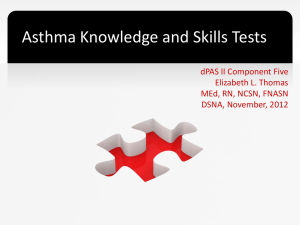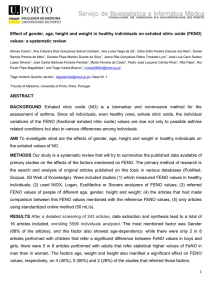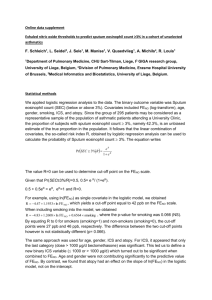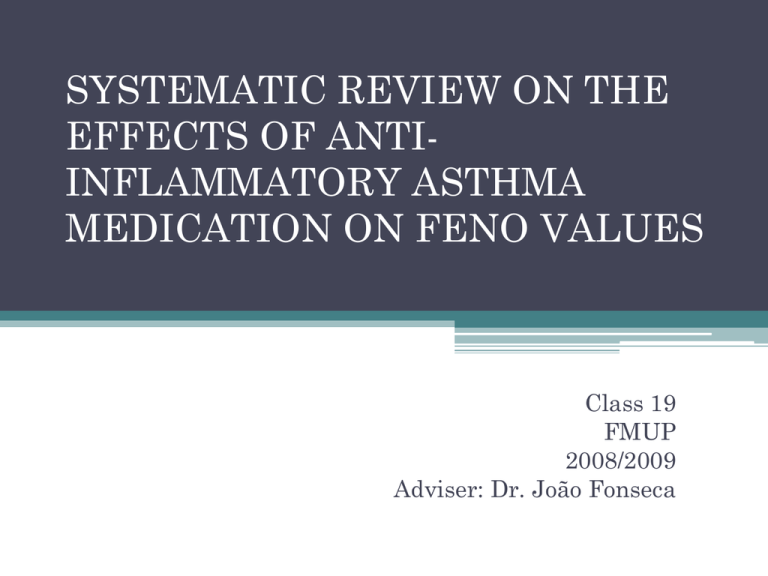
SYSTEMATIC REVIEW ON THE
EFFECTS OF ANTIINFLAMMATORY ASTHMA
MEDICATION ON FENO VALUES
Class 19
FMUP
2008/2009
Adviser: Dr. João Fonseca
INDEX
Statement of the Problem
Background
Main Problem
Aims
Methods
Expected Results
References
STATEMENT OF THE PROBLEM
▫
Asthma is a disease with high prevalence and morbidity 1;
▫ There are different types of Asthma Medication, some have
anti-inflammatory effects;
▫
FENO is a biomarker of airways’ inflammation.
What are the effect of anti-inflammatory
asthma medication on FENO values?
1 GLOBAL INITIATIVE FOR ASTHMA
BACKGROUND
• WHAT IS ASTHMA?
Asthma is a chronic inflammatory disorder of the airways.1
1 GLOBAL INITIATIVE FOR ASTHMA 2006
BACKGROUND
o ASTHMA MEDICATION2:
Antiinflammatory
Agent
Leukotriene
Antagonists
Drugs
Montelukast
Zafirlukast
Zileuton
Fluticasone
Budesonide
Inhaled
Glucocorticoids
Triamcinolone
Flunisolide
Beclomethasone
Mometasone
Oral
Glucocorticoids
Prednisone
Methylprednisolone
Hydrocortisone
2 National Heart, Lung, and Blood Institute;
National Asthma Education
and Prevention Program
BACKGROUND
• WHAT IS NITRIC OXIDE?
-
It’s a gas produced by cells that line the inner wall of the
airways;
- The amount of nitric oxide exhaled shows how much
inflammation there is in the lungs. 3
3 JONGSTE J.C. 2005
MAIN PROBLEM
• Normal values of FENO aren’t clearly
defined;
• FENO values are influenced by demographic
and biological factors;
• Some effects of anti-asthma medication on
FENO values have been reported.
AIMS
• Evaluate the effect of anti-inflammatory
asthma medication and its magnitude on
FENO values, namely:
▫ Leukotriene modifiers;
▫ Inhaled Corticosteroids;
▫ Oral Corticosteroids;
METHODS
• STUDY DESIGN: SYSTEMATIC REVIEW
Phases of a systematic review:
1. Formulation of the Question
2. Search and inclusion of primary studies
3. Quality assessment of included studies
4. Data Extraction
5. Statistical Analysis and synthesis of study results
6. Interpretation of the results and report writing
METHODS
2. Search and Inclusion of primary studies:
• DATA SOURCE:
PUBMED
SCOPUS
ISI Web of Knowledge
Conduction of separate, sensitive searches using
different combination of multiple and alternative keywords
METHODS
2. Selection and Inclusion of primary studies:
INCLUSION OF PRIMARY STUDIES ACCORDING TO THE
INCLUSION AND EXCLUSION CRITERIA:
Search
PUBMED
SCOPUS
ISI
Total
1
183
71
107
359
2
183
71
96
350
3
217
73
111
401
4
259
151
371
781
5
239
147
233
619
6
230
114
114
458
7
230
114
114
458
6:
2:
4:
exhaled
nitric
oxide
AND
OR leukotriene
OR
1:7:asthma
3:
5:
AND
exhaled
nitric
oxideOR
AND
(glucocorticoids
Leukotriene
ORantagonists
antagonists);
Leukotriene
(exhaled
nitric
oxide
OR (glucocorticoids
FENO
ENO)
AND
(glucocorticoids
OR
antagonists)
limits:
OR
Montelukast
since 1990
OR
Zafirlukast
OR
Zileuton
Fluticasone
antagonists);
Montelukast
OR
limits:
Zafirlukast
sinceOR
1990
OR
Zileuton
OR
Fluticasone
OR
Budesonide
leukotriene
antagonists
Montelukast
OROR
Zafirlukast
OR OR
Zileuton OR
Budesonide
OR
OR
Flunisolide
OR
Fluticasone
ORTriamcinolone
Budesonide
OR
ORBeclomethasone
Flunisolide
OR OR
OR
Budesonide
Triamcinolone
OR
Triamcinolone
OR Flunisolide
ORTriamcinolone
OR
Flunisolide
Beclomethasone
OR
Beclomethasone
OR Mometasone
OR OR
Mometasone
OR
Prednisone
OR
Methylprednisolone
OR
Hydrocortisone);
Beclomethasone
OR Mometasone
OR
OR
Methylprednisolone
Prednisone
Mometasone
OR
ORMethylprednisolone
Prednisone
OR Methylprednisolone
ORPrednisone
Hydrocortisone);
OR
Hydrocortisone);
limits: since 1990
limits:
since
1990,
HUMANS
OR Hydrocortisone); limits: since 1990, HUMANS, CLINICAL QUERY limits:
since
HUMANS,
CLINICAL QUERY - Teraphy and sensitive
Therapy
and1990,
sensitive
search
search
METHODS
2. Selection and Inclusion of primary studies:
▫ Selection of the Query:
(Exhaled Nitric Oxide OR FENO OR ENO)
Antagonists OR Glucocorticoids OR Montelukast
Zileuton OR Fluticasone OR Budesonide OR
Flunisolide OR Beclomethasone OR Mometasone
Methylprednisolone OR Hydrocortisone)
AND (Leukotriene
OR Zafirlukast OR
Triamcinolone OR
OR Prednisone OR
LIMITS:
• articles published since 1990 (except on ISI);
• data collected on HUMANS - PUBMED, [AND (humans OR patients
OR volunteers) – SCOPUS and ISI;
• Clinical Queries: Therapy and Sensitive Search – PUBMED, [AND
clinical trial OR therapy OR “therapeutic use”] – SCOPUS and ISI.
METHODS
2. Selection and Inclusion of primary studies:
INCLUSION OF PRIMARY STUDIES ACCORDING TO THE
INCLUSION AND EXCLUSION CRITERIA:
Screen of articles independently by two reviewers and selection of
those appropriate for inclusion.
• Assessing Title/Abstract
• When there isn’t sufficient information, the article will
proceed to the next phase
• When the reviewers disagree on the inclusion or exclusion
of an article, the article is automatically included
• Assessing Full-text
• When the two reviewers disagree on the inclusion or
exclusion of a specific article, the disagreement will be
solved by consensus or request of a third reviewer;
The articles which don’t accomplish the criteria will be excluded
and the reasons for that exclusion will be registered.
•
METHODS
2. Selection and Inclusion of primary studies:
INCLUSION OF PRIMARY STUDIES ACCORDING TO THE
INCLUSION AND EXCLUSION CRITERIA:
Inclusion Criteria:
- Explicit comparison of FENO values in patients treated with antiinflammatory medication with the values in the same patients not on
treatment;
-related to the effects of Oral Corticosteroids,
Corticosteroids or Leukotriene modifiers on FENO values;
Inhaled
- a experimental longitudinal study;
- primary data;
- published since 1990.
Exclusion Criteria:
- in a language either than English, Portuguese or Spanish;
- studies without a rigorous definition about the existence or not of
asthma in the patients, at the beginning of the treatment.
- Not analyzed on humans;
METHODS
3. Quality Assessment of included studies
•
•
•
Quality refers to internal validity of the studies (i.e. lack of
bias).
This task should also be performed independently by two
reviewers basing on a list with selection criteria.
The quality criteria used will depend on the study design,
in our case, selection criteria are, for example, “Were
patients randomized?”, “Was follow up complete?”, etc.
METHODS
4. Data Extraction:
• Reviewers will extract information on the characteristics of the
study, such as its methodology, population, interventions and
outcomes.
• Variables extracted from each article will be:
•Study Identification
- Author;
- Year;
- Nationality.
•Type of Study (Longitudinal – Retrospective or Prospective)
•Study’s Objective
METHODS
4. Data Extraction:
•Study Variables:
Patients:
- Number of participants;
- Age (children, adults);
- Sex (Male or Female);
- Health Condition;
Intervention:
-Type of anti-inflammatory treatment (Leukotriene Antagonists or
Glucocorticoids)
- Treatment duration (0-4 weeks; or 4 weeks to 6 months; or 6 to 12 months;
or more then a year)
- Use of Control or Placebo Groups.
Comparation:
- Of evolution of FENO values:
Between two or more different asthma medication;
Between treated and not treated groups of patients.
Outcomes:
- Treatment influence on FENO values (FENO values before and after
the treatment);
- Development of new sensitivities in patient groups and type of
sensitivity developed (if developed).
METHODS
5. Statistical Analysis and synthesis of study
results
•Tabulation of study characteristics and results. It will made
a statistical analysis and it will be used SPSS for the
descriptive statistics proportion.
•Meta-analysis : combination of the results of previous
studies to achieve at summary conclusions.
6. Interpretation of the results and report
writing:
•Interpretation of results, discussion of issues and
limitations of primary studies included and the conduction of
the review;
EXPECTED RESULTS
•Find enough data that relates the different drugs that compose
the three types of anti-inflammatory asthma medication
(Leukotriene modifiers, inhaled Corticosteroids and oral
Corticosteroids) to variations in FENO values;
•Literature will show a decrease in the FENO values of patients
treated with anti-inflammatory asthma medication.
REFERENCES
1) Global Initiative for Asthma, A Pocket Guide for Physicians and Nurses, 2006
2) National Heart, Lung, and Blood Institute; National Asthma Education and Prevention Program.
Expert Panel Report 3: Guidelines for the Diagnosis and Management of Asthma. 2007. 08-4051
http://adam.about.com/reports/Asthma-in-adults.htm
3) Jongste J.C. Yes to NO:The First Studies on Exhaled Nitric Oxide-Driven Asthma Treatment, 2005,
ERS Journal Ltd, 26:379-381
4) Madhukar P, Systematic reviews and meta-analyses: An illustrated, step-by-step guide, The
National Medical Journal of India VOL. 17, NO. 2, 2004
5) Oddera S., Silvestri M, Balbo A, Jovovich BO, Penna R, Crimmi E, Rossi GA, Airway eosinophilic
inflammation, epithelial damage, and bronchial hiperresponsiveness in patients with mild-moderate,
stable asthma, 1996, 51(2):100-7
6) Consumers Union, Steroid Inhalers Used to Treat Asthma and Chronic Lung Disease, Consumer
Reports Best Buy Drugs, Abril 2006
7) Smith AD, Cowan JO, Brasset KP, Herbison P, Taylor DR, Use of exhaled nitric oxide measurements
to guide treatment in chronic asthma, N Engl J Med, 2005; 352(21):2163-73
8) Buchvald F, Baraldi E, Carraro S, et al. Measurements of exhaled nitric oxide in healthy subjects age
4 to 17 years, J Allergy Clin Immunol 2005;115:1130–1136
9) Pijnenburg W., Hofhuis W., Hop C., Jongste J. C., Exhaled nitric oxide predicts asthma relapse in
children with clinical asthma remission, Thorax 2005;60:215–218
10) Stirling RG, Kharitonov SA, Campbell D, Robinson DS, Durham SR, Chung KF, Barnes PJ,
Increase in exhaled nitric oxide levels in patients with difficult asthma and correlation with symptoms
and disease severity despite treatment with oral and inhaled corticosteroids. Asthma and Allergy
Group, Thorax. 1998 Dec; 53(12):1030-4.
11)
National
Heart
Lumb
and
Blood
Institute,
Asthma,
September
2008,
http://www.nhlbi.nih.gov/health/dci/Diseases/Asthma/Asthma_WhatIs.html
12) MEDLINE Plus, Asthma, http://www.nlm.nih.gov/medlineplus/asthma.html


